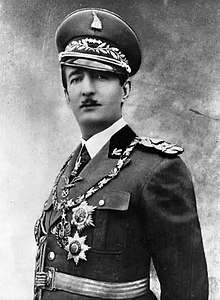First Treaty of Tirana
First and Second Treaties of Tirana
The First Treaty of Tirana (1926) and the Second Treaty of Tirana (1927) were signed in Tirana between Albania and Italy. The two historical documents focused on the Albanian economy and military. They allowed Italy to gain power over the country and join the Axis Powers.
Background
Albania 1920s-1930s
.svg.png)

The two Treaties of Tirana were signed both between Albania and Italy. At the time the country of Albania was under the kingship of Zog I of Albania, known in Albanian as the king of the Albanians, Mbreti i Shqiptarëve. In 1925, Ahmet Zogu, was elected as a President for seven years and on the 1st September 1928, during his swearing ceremony he proclaimed himself as the King[1]. Being the first and the last king of the Albanian nation, he served the country from 1922 until he fled to France during the start of the Second World War in 1939. Albania was thought by Italy as the portal for the rest of the Balkan countries, Greece and the Near Eastern countries[2]. In May 1925, Albania accepted the proposal of the Italians, to find the Albanian National Bank, acting as the country's treasury despite being solely controlled by the Italian banks[3]. For the first time, Albania had its own national coin minted. The proposal came with a five-year loan equivalent of about 2 million pounds of that time.[1] Zog I accepted to restore order in his country and help with its development. The 1925 Agreement also oversaw mineral concessions of the Albanian land[4]. This weakened the King's economic hold and slowly gave way for the two Treaties to be signed by Zog and the Italian dictator, Mussolini.
First Treaty of Tirana (1926)
On November 27 1926, for a period of five years, Italy signed with Albania the First Treaty of Tirana. It pushed Tirana to accept Italian officers and ranking member into their army and police[3] to oversee the Albanian army and train it. King Zog fearing that the unrest of his people will lead to the loss of his throne, signed the Treaty. Italy proclaimed Albania as its "guarantor"[5] which meant that anyone going against the existing Albanian status quo affairs would be seen as an enemy of both the Albanian and Italian states.[1] The two countries would provide support, whether it be military or economic, to each other.
Second Treaty of Tirana (1927)
On November 22 1927, the Second Treaty of Tirana was signed between Albania and Italy, for a period of twenty years.[5] It was a defensive alliance characterised by the Italians as "A Treaty of Peace and Security"[1]. The Treaty allowed the Italians to bring forty officers to train the Albanian army. Military experts started to instruct Albanian paramilitary groups, whilst allowing in the meantime the Italian navy to access the port of Vlorė.[3] The Treaty meant a lot more to the Italians as it enabled them to enter Albania freely, whether a real or fictional threat existed. Their doorway towards the Balkans had opened. The signage of both the First and the Second Treaties gave the Italians the freedom to access and control the Albanian economy and military, making Albania an Italian Protectorate.[1] In Rome, a ministry was created specifically to control the Albanian affairs and count Francesco Giacomoni was appointed regent of Albania.[1]
References
- Brewer, David (2016). "Greece, the Decade at War: Occupation, Resistance and Civil War" (PDF). pp.25-33.
- "The New York Times Archives".
- History of Albania. "Italian Penetration".
- "Memoranda Submitted by the Albanian Government on the Draft Peace Treaty With Italy".
- The Great Soviet Encyclopedia, “Italian-Albanian Treaties and Agreements." (1970-1979). The Gale Group Inc. 2010.